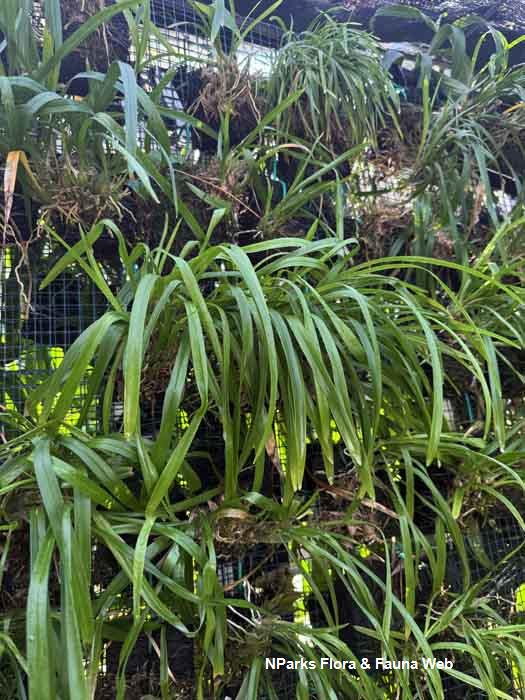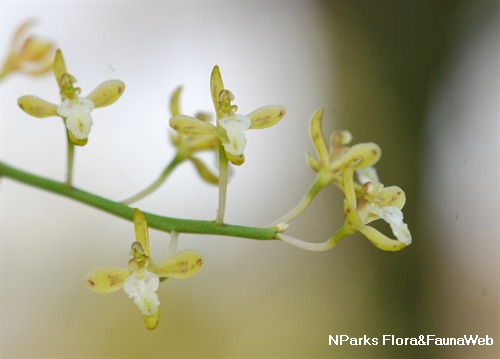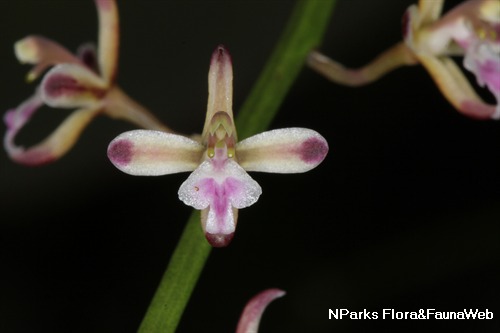
Back
Acriopsis ridleyi Hook.f.
| Family Name: | Orchidaceae |
Acriopsis ridleyi is an epiphytic orchid that grows in clumps on tree branches. It produces clusters of small flowers with yellow petals and sepals with maroon spots.
Name
Classifications and Characteristics
| Plant Division | Angiosperms (Flowering Seed Plants) (Monocotyledon) |
|---|---|
| Plant Growth Form | Epiphyte |
| Lifespan (in Singapore) | Perennial |
| Mode of Nutrition | Autotrophic |
Biogeography
| Native Distribution | Borneo, Singapore, Malaya, Thailand. |
|---|---|
| Native Habitat | Terrestrial |
| Preferred Climate Zone | Tropical |
| Local Conservation Status | Native to Singapore (Critically Endangered (CR)) |
Description and Ethnobotany
| Growth Form | It is an epiphytic orchid which forms a tight clump of pseudobulbs (swollen internodes). All plant parts are glabrous (smooth and without hairs) except the flower lip which is shortly hairy. |
|---|---|
| Roots | This species has two types of roots; the thicker main roots which creep and branch to attach to the host tree, and catch roots which erectly sprout from the root branchlets and form an extensive network to trap leaf litter for nutrients. |
| Foliage | The leaves are leathery, green, measuring about 8.5 - 16.5 cm long and 0.4 - 0.8 cm across, linear-shaped and has cuspidate tips (sharp point that looks like two curves meeting at the tip). |
| Stems | The pseudobulbs are glossy, green and elliptic when young, then becoming matte and ovoid with shallow grooves when older. The pseudobulbs are about 2 - 2.5 cm long and 1 - 1.5 cm across. The basal pseudobulb has a brownish, papery and sheathing bract while the apical pseudobulb has a leaf. |
| Flowers | The inflorescence is a raceme that appears from the base of the the old pseudobulb, about 16 - 32 cm long with 13 - 20 flowers which opens almost simultaneously. The flower bract is small, about 1 mm x 0.5 mm. The flowers are non-resupinate (flower does not turn upside down, hence the flower lip is at the top), measuring 1.4 x 1.4 cm. Sepals and petals are yellow with maroon spots, while the lip is white with purple patch in the middle. |
| Fruit | The fruit is capsule, broadly ellipsoid, measuring about 1.2 cm long x 0.8 cm wide. |
| Habitat | This species is found in lowland dipterocarp forest to coast podzol and kerangas forests, to hill forest on ultramafic substrates. In Singapore, it is found at 145 m above sea level in primary forest, on a steep slope towards the summit of the hill. Note: Ultramafic substrates are characterised with high concentrations of magnesium and nickel, low water retention capacity, low available phosphorus, and low concentrations of other essential plant nutrients such as nitrogen and potassium. <1> |
| Cultivation | Plant can grow under semi shade to bright filtered light. Plant can be propagated by seed and division. Each division consists of 3 to 4 pseudobulbs, with the cuttings mounted on fern back and covered by a layer of sphagnum moss. Place the plant under 50% shade. |
Plant Care and Propagation
| Light Preference | Semi-Shade |
|---|---|
| Water Preference | Moderate Water |
| Plant Growth Rate | Moderate to Slow |
| Propagation Method | Seed, Division |
Foliar
| Foliage Retention | Evergreen |
|---|---|
| Mature Foliage Colour(s) | Green |
| Mature Foliage Texture(s) | Leathery |
| Prominent Young Flush Colour(s) | Green |
| Young Flush Texture(s) | Leathery |
| Foliar Type | Simple / Unifoliate |
| Foliar Shape(s) | Non-Palm Foliage (Linear) |
| Foliar Venation | Parallel |
| Foliar Margin | Entire |
| Foliar Apex - Tip | Cuspidate |
Floral (Angiosperm)
| Flower & Plant Sexuality | Bisexual Flowers |
| Flower Colour(s) | Yellow / Golden, White, Purple |
|---|---|
| Flower Texture(s) | Smooth |
| Flower Grouping | Cluster / Inflorescence |
| Flower Location | Axillary |
| Flower Symmetry | Bilateral |
| Individual Flower Shape | Labiate / Lipped |
| Inflorescence Type | Raceme |
Fruit, Seed and Spore
| Fruit Classification | Simple Fruit |
|---|---|
| Fruit Type | Dehiscent Dry Fruit , Capsule |
| Seed Quantity Per Fruit | Numerous (>20) |
References
| References | <1> Ent, A. (2011). The ecology of ultramafic areas in Sabah: threats and conservation needs. The Gardens' Bulletin, Singapore, 63, 385-393. <2> Paul et. al (2018). Acriopsis ridleyi Hook.f. (Orchidaceae): Re-encounter of an orchid thought extinct since its 1889 holotype collection in Singapore. Nature in Singapore, 11:27-36 |
|---|
Image Repository
Others
| Master ID | 34490 |
|---|---|
| Species ID | 8903 |
| Flora Disclaimer | The information in this website has been compiled from reliable sources, such as reference works on medicinal plants. It is not a substitute for medical advice or treatment and NParks does not purport to provide any medical advice. Readers should always consult his/her physician before using or consuming a plant for medicinal purposes. |


